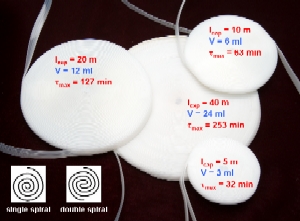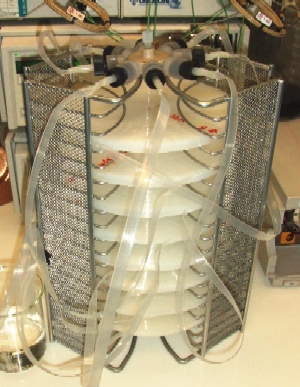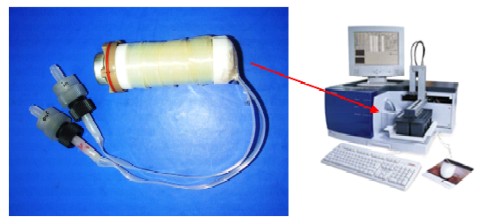Micro flow disk (MFD) technology
Lead researcher: Christian Hornung
Assistance gratefully acknowledged from Prof. Steven Ley and Dr. Ian Baxendale, Dept. of Chemistry, University of Cambridge.
The use of MCFs as a chemical reactor has excited much interest and has led to the development of the Micro flow disk or MFD. The existing poly- (ethylene) MCFs have proved to be highly solvent tolerant below 70� Celsius and has therefore allowed a number of proof-of-concept reactions to be investigated in a variety of MFD geometries. MFD have been fabricated that contain between 5 metres and 40 metres of MCF, giving up to a total of 760 metres of microfluidic pathway for a 40 metre MFD. Maximum fluid hold ups and residence time for these devices range between 24ml and 253 minutes for the 40 metre MFD and 3ml and 32 minutes for the 5 metre MFD. A collection of MFDs are shown in the photograph below.

The opacity of various plastics to certain classes of EM radiation, for example UV and microwave, opens up a number of potentially interesting application areas for these devices, such as the investigation of photochemical reactions or the online-analysis inside the MCF using various spectroscopy methods. Furthermore, research is ongoing to produce MCF-based reactors containing catalytic capillary walls. A major advantage of the MFD system is the ability to go from a bench-top scale to pilot-scale by simply numbering-up the amount of reactor units used. The photograph below shows eight 40 metre reactors connected in parallel, giving a little over 6 km of microfluidic pathway.

A series of different, but commonly used, organic reactions were used to validate the MFD technology up to this point. These include heterocyclic ring formation, amidation, simple phenolic allylation and Diels-Alder reactions. The reactions were performed on different scales ranging from analytical quantities in the order of 2 ml per run, up to a full capacity of 4 kilos per day of final crystalline product. Both high conversion and purity of the product in a reliable fashion could be achieved, using MFDs, which are capable of operating across a broad range of scales.
The performance of MCF microwave reactor devices based on a different geometry than the MFD has been evaluated using an Emrys Optimser laboratory microwave reactor. Here a small Teflon insert with 4 metres of MCF, coiled around it, was placed inside the microwave cavity. Microwave irradiation was used to control the temperature inside the fluid bulk flowing through the capillaries, thus initiating the reaction. The formation of pyrazoles was carried out successfully as a first proof-of-concept reaction using this device.

In order to enhance the solvent tolerance and temperature resilience of MCF-based reactor systems, a license to manufacture high-performance fluoropolymer MCFs has been granted to Lamina Dielectrics Ltd. We are currently in the process of collaborating with Lamina on the design and commissioning of the extrusion tooling and it is anticipated that fluoropolymer MCF systems will be available towards the end of 2007.

